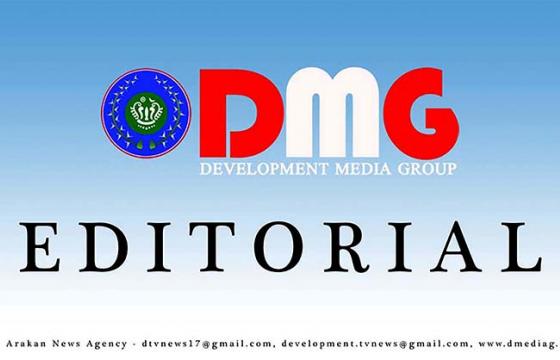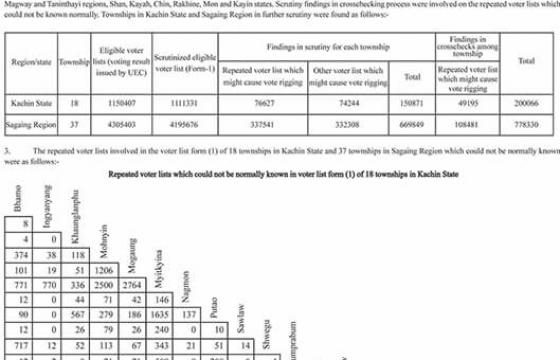With the United Nationalities Alliance (UNA) taking up position on the naming of the bridge as “Bogyoke Aung San”, in Mon State known as “Thanlwin” bridge, the controversial issue has taken an active spin, which was followed by a massive protest on March 19 Sunday, to keep to the old name that is preferred by the local people.
It all started out as the bridge’s proposed name became known when the Ministry of Construction sent a letter to Aung Naing Oo, deputy speaker of the Mon State parliament, announcing a celebratory opening ceremony for it on February 13, the 102nd birthday of Gen Aung San. Locals were outraged by the decision and the opening was canceled, according to the Irrawaddy report of March 15.
On March 2, some three thousand Mon population, including the Mon State deputy parliament speaker protested against the naming of the bridge, which was endorsed without the consent of the people.
On March 14, however, Speaker Win Myint put it to a vote after 15 Hluttaw representatives spoke on the bridge name, the motion to name it Bogyoke Aung San Bridge was approved with a majority vote from NLD representatives. Accordingly, the proposal resulted in 217 lawmakers voting in favor, 43 against and 116 abstaining.
On March 18, the UNA, which consists of a dozen ethnic political parties, issued a 5 point statement underlining that the parliamentarians of the ruling NLD party should not use their majority vote to override the desire of the local Mon State population.
Furthermore, the statement warned that this act of using majority vote could harm the life security of the ethnic peoples in the future.
Sai Nyunt Lwin, general secretary of the Shan Nationalities League for Democracy (SNLD), whose party is also an UNA member elaborated to the Radio Free Asia recently, regarding the statement: “In any issues they [the National League for Democracy (NLD)] could decide according to their desire, as they have the majority in lower, upper and union parliaments. They should avoid taking measures that could hurt the minorities and pay attention to the minorities’ desire. And if issues would be decided neglecting the minorities’ concern, a lot of worries could arise. (For example), we won’t be able to do anything if they want to change the name of Taunggyi (the Shan State capital)”.
On March 19 Sunday, over twenty thousand people, involving Mon, Pa-O, Karen and locals, staged a demonstration in Mawlamyine, also known as Moulmein, strand road against the naming of the bridge as “Bogyoke Aung San”, chanting slogans that they rejected the parliament endorsed name.
The combined demonstrator groups also issued a statement to acknowledge the local people’s desire; perpetuation of national unity; national reconciliation; emergence of a genuine democratic country and federal union that is anchored in the rights of self-determination.
Difficult choice of name?
According to Union Minister for Ethnic Affairs Nai Thet Lwin: “Whoever you ask – local resident, monk, historian or politician – you will get a different answer. There was a suggestion to name it Thamein Bayan Bridge. Another person preferred the name Thanlwin Bridge,” reported the Myanmar Times of March 17.
“If you ask a local from Mawlamyine, they would reply “Mawlamyine Bridge” and if you ask a local from Chaungzone, it would be “Chaungzone.” If you name it Mawlamyine-Chaungzone-Thanlwin Bridge, that may satisfy residents on both banks,” said the Ethnic Affairs Minister.
But March 14 report of the Irrawaddy said that residents favored naming the bridge linking Moulmein and Chaungzon townships “Yamanya”, meaning Mon State in Mon language, or “Salween Bridge” or “Thanlwin Bridge”.
Whatever the case, one thing is sure and that is the rejection of the parliament approved name that is given after the independence struggle hero “Bogyoke Aung San Bridge”.
Minority right in jeopardy?
As it is, even though there is already an endorsement by the parliament to go ahead, nothing has yet been decided.
But alarm bell has been rung, especially in the ears of the ethnic population, that the NLD is ready to bully with its majority votes to achieve its desire, whether such a generalization is logically valid or not is, of course, debatable.
It is true that the country is still not a full fledged federal union, but the NLD should make use of its majority vote cautiously where the minorities are involved, so that minority rights could be protected, has been the main concern of the ethnic states.
The argument goes that if such a small matter of even naming the bridge could be bullied, how would it look like when hardball political bargaining would come into play.
It should be noted that this episode is viewed by the non-Bamar ethnic as the NLD catering to Bamar ethnocentrism, no different from the successive military regimes, and is pushing the ethnic states’ population to accept assimilation and acculturation, at the expense of diluting their own identity and culture.
In the same vein, in February, the locals in the Kachin State capital Myitkyina and Mon State’s Mudon Township have raised objections to planned statues of Burma’s independence hero Gen Aung San in the two locations.
Construction has already begun on plinths for the statues in the town centers of Myitkyina and Mudon but civil society groups complained that they cannot accept the statues while there is ongoing conflict in Kachin State and the federalism and equality pledged by Gen Aung San in the Panglong Agreement of 1947 remains unfulfilled, according to the report of the Irrawaddy on February 8.
Although polite arguments were being given, in reality the non-Bamar ethnic nationalities consider all these moves to be a camouflage assimilation or Burmanization scheme, which they must resist. But this is not to say that they don’t respect Aung San. They still consider him – then in 1947 and also now – to be a great statesman and Bamar national leader, whom they could trust and work together for ethnic harmony. But unfortunately he was assassinated before the achievement of independence from the British, in 1947. Subsequently, all the promises made by him as a Bamar national leader were watered down during the constitutional drafting, which has left the non-Bamar ethnic nationalities at disadvantage, leading to the constitutional crisis that isn’t able to be resolved, up to these days.
For now, it seems the NLD is confronting in Mon State “A bridge too far” – meaning: A step or act that is regarded as being too drastic to take – sort of scenario, which it has lightly thought out that it could be overcome easily.
Given such controversy and emotionally charged atmosphere, the NLD and its boss State Counselor Aung San Suu Kyi should be cautioned and reminded that a withdrawal from such confrontation would be a wiser way to go than pushing it stubbornly through, if the gradually depleting trust of the ethnic nationalities is to be restored.






